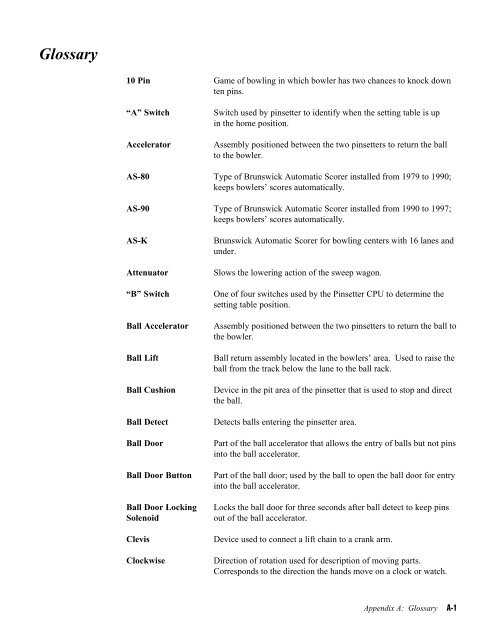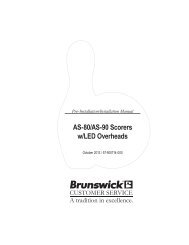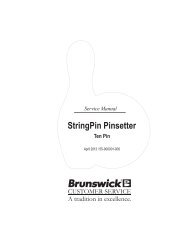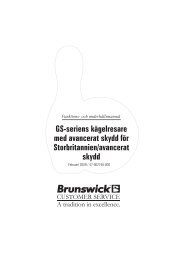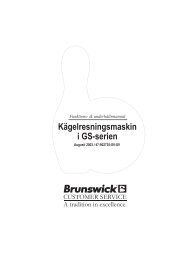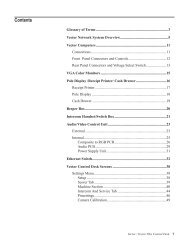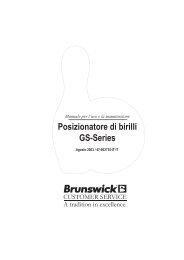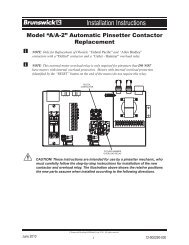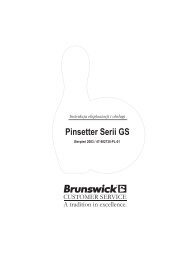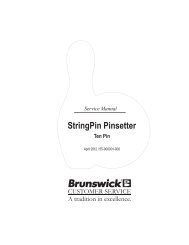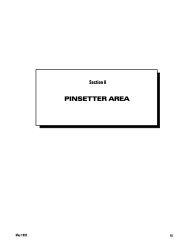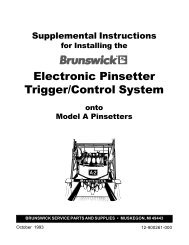You also want an ePaper? Increase the reach of your titles
YUMPU automatically turns print PDFs into web optimized ePapers that Google loves.
Glossary<br />
10 Pin Game of bowling in which bowler has two chances to knock down<br />
ten pins.<br />
“A” Switch Switch used by pinsetter to identify when the setting table is up<br />
in the home position.<br />
Accelerator Assembly positioned between the two pinsetters to return the ball<br />
to the bowler.<br />
AS-80 Type of <strong>Brunswick</strong> Automatic Scorer installed from 1979 to 1990;<br />
keeps bowlers’ scores automatically.<br />
AS-90 Type of <strong>Brunswick</strong> Automatic Scorer installed from 1990 to 1997;<br />
keeps bowlers’ scores automatically.<br />
AS-K <strong>Brunswick</strong> Automatic Scorer for bowling centers with 16 lanes and<br />
under.<br />
Attenuator Slows the lowering action of the sweep wagon.<br />
“B” Switch One of four switches used by the Pinsetter CPU to determine the<br />
setting table position.<br />
Ball Accelerator Assembly positioned between the two pinsetters to return the ball to<br />
the bowler.<br />
Ball Lift Ball return assembly located in the bowlers’ area. Used to raise the<br />
ball from the track below the lane to the ball rack.<br />
Ball Cushion Device in the pit area of the pinsetter that is used to stop and direct<br />
the ball.<br />
Ball Detect Detects balls entering the pinsetter area.<br />
Ball Door Part of the ball accelerator that allows the entry of balls but not pins<br />
into the ball accelerator.<br />
Ball Door Button Part of the ball door; used by the ball to open the ball door for entry<br />
into the ball accelerator.<br />
Ball Door Locking Locks the ball door for three seconds after ball detect to keep pins<br />
Solenoid out of the ball accelerator.<br />
Clevis Device used to connect a lift chain to a crank arm.<br />
Clockwise Direction of rotation used for description of moving parts.<br />
Corresponds to the direction the hands move on a clock or watch.<br />
Appendix A: Glossary<br />
A-1
A-2<br />
Appendix A: Glossary<br />
Closed Switch position in which two contacts are touching to create a path.<br />
Comline Communication path between two electronic devices.<br />
Counterclockwise Direction of rotation used for description of moving parts. Corresponds<br />
to the direction opposite the hand movement on a clock or<br />
watch.<br />
CPU (Central Processing Unit) - circuit board in the Universal<br />
Nexgen Box that performs as the brain for the pinsetter.<br />
Cycle A series of events that recur regularly and ends back at the starting<br />
point.<br />
“D” Switch One of four switches used by the Pinsetter CPU to determine the<br />
setting table position.<br />
Detection Stroke Initial lowering of the setting table after ball detect. Used to<br />
determine what the bowler did and what the pinsetter must do to<br />
get ready for the next ball.<br />
Diagnostics A self test mode used by pinsetter to locate problems and to check<br />
performance.<br />
Distributor Assembly that moves and positions pins over the setting table for<br />
eventual loading.<br />
Distributor Rails Guide rails for keeping the green belts in place as they move pins<br />
throughout the distributor.<br />
Double Detect Method of pinsetter operation when the pinsetter detects for pins<br />
on first ball and second ball. This is used when the pin holders’<br />
switches are used for providing pin count to the automatic scorer.<br />
Driving Drum Large pulleys which support the ball accelerator’s flat belt.<br />
Dust Pan Sheet metal “pan” located under the front of the distributor to<br />
collect dust and dirt that falls off the green belts and bowling pins<br />
as they transfer from one set of belts to another.<br />
EC Switch Elevator control switch that monitors movement of the pin shovels.<br />
Elevator Assembly used to lift pins up from the transport band to the<br />
distributor.<br />
Error Codes Codes provided by the Pinsetter CPU to direct you to specific<br />
problem it has detected in the pinsetter.<br />
Foul Line Black line on the lane dividing the bowlers approach area from the<br />
playing area in which the ball rolls down the lane.
Foul Condition in which a bowler crosses the foul line. Results in loss of<br />
pincount on that ball.<br />
Frameworx Type of <strong>Brunswick</strong> Automatic Scorer installed from 1994 to<br />
present; keeps bowlers’ scores automatically.<br />
Function Switch A switch which monitors a specific operation or function of the<br />
pinsetter’s movements.<br />
Function Solenoid A solenoid that controls a specific operation for the pinsetter.<br />
“G” Switch A function switch that monitors the sweep wagon’s up and down<br />
positioning.<br />
Gripper Part of the pin holder used to trip the pin release lever and keep<br />
the pin in the pin holder.<br />
Ground (Earth) -A conducting connection, whether intentional or accidental,<br />
between an electrical circuit or equipment and the earth. Generally<br />
used as a reference point for measuring voltages in a circuit.<br />
Gutter Adapter Plastic appendages protruding down from the sweep wagon that<br />
clear any pins left in the flat gutters on either side of the pin deck.<br />
Gutter Channel on each side of the lane which guides the ball back to the<br />
pinsetter after it has left the lane surface.<br />
Hertz Cycles per second. The unit of measure for frequency.<br />
High Voltage Voltage typically used to power motors and transformers.<br />
Hydraulic Shock Shock absorber that uses hydraulic fluid to dampen the impact of<br />
Absorber the ball, the lowering of the setting table and the lowering of the<br />
sweep wagon.<br />
I/O (Input/Output) - An electronic circuit board that directs signals into<br />
and out of the CPU.<br />
Invalid Machine A condition in which the Pinsetter CPU is not able to determine the<br />
State position of the sweep wagon, setting table and spotting tongs.<br />
Locking Bolt Part of the ball door locking mechanism. Prevents the ball door<br />
from opening. For 3 seconds after a ball detect.<br />
Machine Cycle A self test mode used by the mechanic to locate problems<br />
Diagnostics by continuously cycling to check for proper operation.<br />
Masking Unit Device that is mounted in front of the pinsetter to hide it from the<br />
bowlers’ view.<br />
Appendix A: Glossary<br />
A-3
A-4<br />
Appendix A: Glossary<br />
Mode Type of operation the pinsetter will be operated under.<br />
New Pin The second table operation during a cycle in which the table will<br />
Setting Stroke lower to the 15 mm level to provide a smooth transfer of the pins<br />
from the table to the lane surface.<br />
Frameworx Pinsetter operating mode used to operate with Frameworx automatic<br />
scoring systems.<br />
Normally Closed A switch connection in which a path only exists between the<br />
“Common” and the “NC” when the switch is in an at-rest condition.<br />
Normally Open A switch connection in which a path only exists between the<br />
“Common” and the “NO” when the switch is actuated.<br />
Open Contacts which are not connected or touching.<br />
Out-Of-Range Bowling condition in which a bowling pin is moved off its spot but<br />
is still left standing on the pin deck. Pinsetter cannot handle this pin<br />
automatically.<br />
PCB Printed Circuit Board.<br />
Pin Count Switch Switch mounted to the top of the elevator to monitor pins leaving<br />
the pin shovels.<br />
Pin Detector Plate on the bottom of the pin holder that is pushed up by<br />
Plate the top of a bowling pin when the table lowers to detect for pins<br />
left standing.<br />
Pin Holder One of 10 assemblies on the setting table used to hold pins while<br />
setting them on the lane surface.<br />
Pin Light Light mounted on the front of the pinsetter. Provides light to the<br />
bowling pins when they are standing on the pin deck.<br />
Pin Release Part of the pin station contacted by the pin holder’s gripper to drop<br />
Lever the pin into the pin holder.<br />
Pin Shovel One of 14 assemblies in the elevator used to lift pins from the pit to<br />
the distributor.<br />
Pin Station One of 10 temporary storage devices the distributor uses for<br />
holding pins until the table is ready for them.<br />
Polycord Type of material used in the pinsetter’s pin handling belts.<br />
Preventive Scheduled activity; cleaning, lubrication and adjusting required on<br />
Maintenance any machinery to keep it working reliably.
Rear Control Box A switch box mounted on the side of the elevator.<br />
Reset A switch signal that cycles the pinsetter to the next ball.<br />
Retroreflector A reflector that sends a transmitted beam back to the original<br />
source.<br />
Set Switch that provides the pinsetter the capability of setting the last<br />
known combination of pins.<br />
Setting Table Assembly used to detect standing pins on the pin deck and also to<br />
transfer pins from the distributor to the pin deck.<br />
Shark Solenoid The red solenoid has been added to GS-96 and later pinsetters to<br />
control the direction of the pin guide while feeding pins to the<br />
distributor’s pin stations.<br />
Shark Switch A switching assembly that alternates pins to the left and right side<br />
of the distributor.<br />
Short Cycle An abbreviated pinsetter cycle in which the sweep operation is not<br />
performed.<br />
Single Detect Method of pinsetter operation when it detects for pins on first ball<br />
only. This is used when no automatic scoring is available or when<br />
an external pin counting device (Scanner or CCD camera) is used.<br />
Single Phase Power An alternating current circuit in which only phase of current and<br />
voltage is available in a two conductor or three conductor system.<br />
SM Switch Sweep Motor switch - informs the Pinsetter CPU that the sweep<br />
is forward when its contacts are closed.<br />
Spotting Tongs Set of ten pairs of plastic devices mounted on the setting table.<br />
They are gear driven closed and open to pick up pins during<br />
respotting for a second ball.<br />
Solenoid - A solenoid designed to be energized for extended periods of time.<br />
Continuous Duty (Red - Pin Holder Solenoids).<br />
Solenoid - A solenoid designed to be energized only long enough to perform<br />
Intermittent Duty one brief function. (Black - Function Solenoids)<br />
Square Shafts Two shafts used to remotely drive or control operations on the<br />
setting table. Left - swing shafts; Right - spotting tongs.<br />
ST Switch Spotting Tong switch - monitors the position of the spotting tongs.<br />
Standalone Used to describe GS-Series Pinsetters operations in which a scoring<br />
system does not control pinsetter movement or decision making.<br />
Appendix A: Glossary<br />
A-5
A-6<br />
Appendix A: Glossary<br />
Strike A condition in which all ten pins were knocked down by the<br />
bowler’s first ball of the frame.<br />
Stroke Limiter Used to allow the setting table to lower only part of the way for pin<br />
Plate detection and respotting pins.<br />
Stroke Limiter Energizes to allow the table to lower to the new pin setting height<br />
Solenoid and allows the pin holders to go vertical.<br />
Sweep Release Part of the sweep release mechanism that is pulled rearward to<br />
Lever allow the sweep release to collapse and lower the sweep.<br />
Sweep Release Arm Main frame of the sweep release mechanism.<br />
Sweep Wagon Assembly used to clear deadwood and unwanted pins off of the pin<br />
deck and out of the flat gutters.<br />
Swing Shafts Setting table shafts on which the pin holders are mounted. These<br />
shafts are swung to the vertical position to set pins and returned to<br />
the horizontal position to detect and load pins.<br />
Switch A device used for making, breaking or changing connections in an<br />
electrical circuit.<br />
Switch Cluster Group of four switches (“A,” “B,” “C” and “D”) located on the<br />
right-hand drive frame and used by the pinsetter to monitor the<br />
setting table’s position.<br />
T Stop Device mounted on the top of the left-hand tower rack. Stops the<br />
lowering of the setting table when it contacts the stroke limiter<br />
plate.<br />
Table (Setting Table)- Assembly used to detect for pins standing on the<br />
pin deck and also to set pins on the pin deck.<br />
Tel-E-Foul <strong>Brunswick</strong> electrical assembly mounted at the foul line of the lane.<br />
Detects when a bowler has crossed the foul line.<br />
Three Phase Power Three separate outputs from a single source. There is a phase<br />
difference of 120 degrees between any two of the three voltages<br />
and currents.<br />
Tipper Part of the sweep release mechanism that rotates to allow the<br />
sweep to drop into the guarding, ready to sweep position.<br />
Tongs See Spotting Tongs.<br />
Transformer An electrical device that converts voltage from one level to another<br />
level.
Transport Band Band in the GS-Series Pinsetter pit area that carries the ball and<br />
bowling pins rearward to the accelerator and elevator.<br />
TS-1 Switch A jam switch provided to protect the pinsetter when the pin holders<br />
are unable to return to the horizontal position after setting new<br />
pins.<br />
TS-2 Switch A jam switch mounted on the tower to protect the pinsetter if a pin<br />
jam or broken part prevents the setting table from raising to its<br />
highest position.<br />
VAC Voltage - Alternating Current<br />
VDC Voltage - Direct Current<br />
Work Platform Wooden stand mounted onto the front of the pinsetter. Used by<br />
the mechanic to stand on while viewing or working on the front of<br />
the pinsetter.<br />
Appendix A: Glossary<br />
A-7


